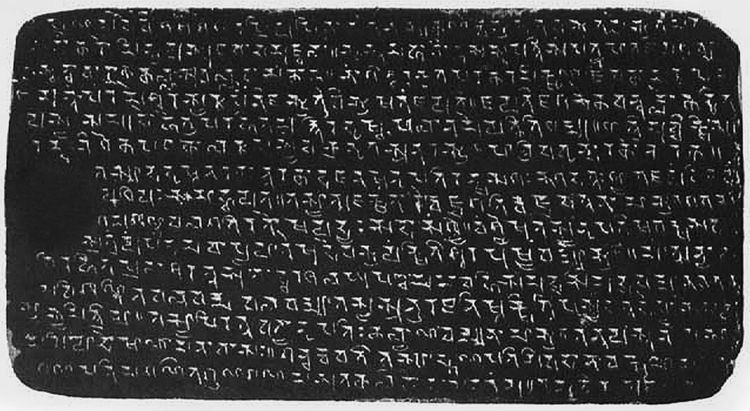Glottolog None | Era First millennium | |
 | ||
Language family Indo-EuropeanIndo-IranianIndo-AryanEasternKamarupi Prakrit | ||
Kamarupi Prakrit, Kamrupi Apabhramsa, old Kamrupi dialect, Kamarupa dialect and proto-Kamrupa; was the Middle Indo-Aryan (MIA) used in ancient Kamarupa. This language is the historical ancestor of the Kamatapuri lects and the Assamese language; and can be dated prior to 1250 CE, when the proto-Kamta language, the parent of the Kamatapuri lects, began to develop. This sort of Sporadic Apabhramsa is a mixture of Sanskrit, Prakrit and colloquial dialects of Assam.
Contents
The evidence of this MIA exist in systematic errors in the Sankrit language used in the Kamarupa inscriptions. A distinguishing characteristic of Kamarupa inscriptions is the replacement of ś and ṣ by s, which is contrary to Vararuci's rule, the main characteristic of Magadhi Prakrit, which warrants that ṣ and s are replaced by ś. Linguists claim this apabhramsa gave rise to various eastern Indo-European languages like modern Assamese and felt its presence in the form of Kamrupi and North Bengali.
Characteristics
Though the epigraphs were written in classical Sanskrit in kavya style of a high degree, they abound in corrupt and unchaste forms.
Apabhramsa
Some linguists claim that there existed a Kamrupi apabhramsa as opposed to the Magadhi apabhramsa from which the three cognate languages---Assamese, Bengali and Odia and Maithili---sprouted. The initial motive comes from extra-linguistic considerations. Kamarupa was the most powerful and formidable kingdom in the region which provided the political and cultural influence for the development of the Kamrupi apabhramsa. Xuanzang's mention that the language spoken in Kamarupa was a 'little different' from the one spoken in Pundravardhana is provided as evidence that this apabhramsa existed as early as the 5th century. That Kamarupa remained unconquered till the beginning of the Assamese literature in the 14th century points to the possibility that the apabhramsa of the Kamarupa kingdom must have flourished. Archaic forms found in epigraphic records from the Kamarupa period give evidence of this apabhramsa, of which there are numerous examples.
The Buddhist Charyapadas from the 8th to 12th century are claimed by different languages: Assamese, Bengali, Odia and Maithili languages. But the geographical region of its composition was the Kamarupa pitha and many of the composers were Kamarupi siddhas. Therefore the language in the Charyapadas is the best example of this apabhramsa. H. P. Sastri, who discovered these poems, termed the language sandhya bhasha (twilight language) and this is nothing but the Kamarupi apabhramsa.
Geographical vicinity
Assamese, or more appropriately the old Kamarupi dialect entered into Kamrup or western Assam, where this speech was first characterized as Assamese. Golockchandra Goswami in his An introduction to Assamese phonology writes, "in early Assamese there seems to be one dominant dialect prevailing over the whole country, the Western Assamese dialect." Similarly Upendranath Goswami says, "Assamese entered into Kamarupa or western Assam where this speech was first characterised as Assamese. This is evident from the remarks of Hiuen Tsang who visited the Kingdom of Kamarupa in the first half of the seventh century A.D., during the reign of Bhaskaravarman"
